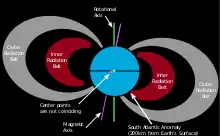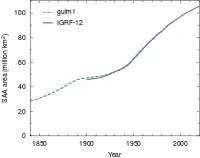South Atlantic Anomaly
The South Atlantic Anomaly (SAA) is an area where Earth's inner Van Allen radiation belt comes closest to Earth's surface, dipping down to an altitude of 200 kilometres (120 mi). This leads to an increased flux of energetic particles in this region and exposes orbiting satellites to higher-than-usual levels of radiation.

The effect is caused by the non-concentricity of Earth and its magnetic dipole. The SAA is the near-Earth region where Earth's magnetic field is weakest relative to an idealized Earth-centered dipole field.
Definition
The area of the SAA is confined by the intensity of Earth's magnetic field at less than 32,000 nanotesla at sea level,[2] which corresponds to the dipolar magnetic field at ionospheric altitudes.[3] However, the field itself varies in intensity as a gradient.[2]:Figure 1
Position and shape

The Van Allen radiation belts are symmetrical about the Earth's magnetic axis, which is tilted with respect to the Earth's rotational axis by an angle of approximately 11°. The intersection between the magnetic and rotation axes of the Earth is located not at the Earth's center, but some 450 to 500 km (280 to 310 mi) away. Because of this asymmetry, the inner Van Allen belt is closest to the Earth's surface over the south Atlantic Ocean where it dips down to 200 km (120 mi) in altitude, and farthest from the Earth's surface over the north Pacific Ocean.[4][5]


If Earth's magnetism is represented by a bar magnet of small size but strong intensity ("magnetic dipole"), the SAA variation can be illustrated by placing the magnet not in the plane of the Equator, but some small distance North, shifted more or less in the direction of Singapore. As a result, over northern South America and the south Atlantic, near Singapore's antipodal point, the magnetic field is relatively weak, resulting in a lower repulsion to trapped particles of the radiation belts there, and as a result these particles reach deeper into the upper atmosphere than they otherwise would.[6]
The shape of the SAA changes over time. Since its initial discovery in 1958,[7] the southern limits of the SAA have remained roughly constant while a long-term expansion has been measured to the northwest, the north, the northeast, and the east. Additionally, the shape and particle density of the SAA varies on a diurnal basis, with greatest particle density corresponding roughly to local noon. At an altitude of approximately 500 km (310 mi), the SAA spans from −50° to 0° geographic latitude and from −90° to +40° longitude.[8] The highest intensity portion of the SAA drifts to the west at a speed of about 0.3° per year, and is noticeable in the references listed below. The drift rate of the SAA is very close to the rotation differential between the Earth's core and its surface, estimated to be between 0.3° and 0.5° per year.
Current literature suggests that a slow weakening of the geomagnetic field is one of several causes for the changes in the borders of the SAA since its discovery. As the geomagnetic field continues to weaken, the inner Van Allen belt gets closer to the Earth, with a commensurate enlargement of the SAA at given altitudes.
Effects
The South Atlantic Anomaly is of great significance to astronomical satellites and other spacecraft that orbit the Earth at several hundred kilometers altitude; these orbits take satellites through the anomaly periodically, exposing them to several minutes of strong radiation, caused by the trapped protons in the inner Van Allen belt. The International Space Station, orbiting with an inclination of 51.6°, requires extra shielding to deal with this problem. The Hubble Space Telescope does not take observations while passing through the SAA.[9] Passing through the anomaly caused false alarms on Skylab Apollo Telescope Mount's solar flare sensor.[10] Astronauts are also affected by this region, which is said to be the cause of peculiar "shooting stars" (phosphenes) seen in the visual field of astronauts, an effect termed cosmic ray visual phenomena.[11] Passing through the South Atlantic Anomaly is thought to be the reason for the failures of the Globalstar network's satellites in 2007.[12]
The PAMELA experiment, while passing through the SAA, detected antiproton levels that were orders of magnitude higher than expected. This suggests the Van Allen belt confines antiparticles produced by the interaction of the Earth's upper atmosphere with cosmic rays.[13]
NASA has reported that modern laptops have crashed when Space Shuttle flights passed through the anomaly.[14]
In October 2012, the SpaceX CRS-1 Dragon spacecraft attached to the International Space Station experienced a transient problem as it passed through the anomaly.[15]
The SAA is believed to have started a series of events leading to the destruction of the Hitomi, Japan's most powerful X-ray observatory. The anomaly transiently disabled a direction-finding mechanism, causing the satellite to rely solely on gyroscopes that were not working properly, after which it spun out of control, losing its solar panels in the process.[16]
References
- Snowden, S. L.; Arida, Michael. "South Atlantic Anomaly". ROSAT Guest Observer Facility. Retrieved October 16, 2007.
- Pavón-Carrasco, F. Javier; De Santis, Angelo (April 2016). "The South Atlantic Anomaly: The Key for a Possible Geomagnetic Reversal". Frontiers in Earth Science. 4. 40. Bibcode:2016FrEaS...4...40P. doi:10.3389/feart.2016.00040.
- Rao, G. S. (2010). Global Navigation Satellite Systems: With Essentials of Satellite Communications. New Delhi: Tata McGraw-Hill. p. 125. ISBN 978-0-07-070029-1.
- Stassinopoulos, Epaminondas G.; Xapsos, Michael A.; Stauffer, Craig A. (December 2015). "Forty-Year 'Drift' and Change of the SAA". NASA Goddard Spaceflight Center. NASA/TM-2015-217547, GSFC-E-DAA-TN28435. Cite journal requires
|journal=(help) - Crotts, Arlin (2014). The New Moon: Water, Exploration, and Future Habitation. Cambridge University Press. p. 168. ISBN 978-0-521-76224-3.
- "FAQ: "The Great Magnet, the Earth"". NASA. Retrieved July 31, 2015.
- Broad, William J. (5 June 1990). "'Dip' on Earth is Big Trouble in Space". The New York Times. Retrieved 31 December 2009.
- "The South Atlantic Anomaly". Ask an Astrophysicist. NASA. 4 October 1996. Archived from the original on 5 November 2007. Retrieved 16 October 2007.
- "Hubble Achieves Milestone: 100,000th Exposure". Space Telescope Science Institute. July 18, 1996. Retrieved January 25, 2009.
- Elder, Donald C. (1998). "The Human Touch: The History of the Skylab Program". In Mack, Pamela E. (ed.). From Engineering Science to Big Science: The NACA and NASA Collier Trophy Research Project Winners. The NASA History Series. NASA. SP-4219.
- "What is the South Atlantic Anomaly?". Ask the Astronomer. Retrieved December 6, 2009.
- "Space Intelligence News" (PDF). Ascend. March 2007. Archived from the original (PDF) on 2007-02-14.
- Adriani, O.; Barbarino, G. C.; Bazilevskaya, G. A.; Bellotti, R.; Boezio, M.; et al. (August 2011). "The Discovery of Geomagnetically Trapped Cosmic-Ray Antiprotons". The Astrophysical Journal Letters. 737 (2). L29. arXiv:1107.4882. Bibcode:2011ApJ...737L..29A. doi:10.1088/2041-8205/737/2/L29.
- Siceloff, Steven (June 28, 2010). "Shuttle Computers Navigate Record of Reliability". NASA. Retrieved July 3, 2010.
- Bergin, Chris (October 19, 2012). "Dragon enjoying ISS stay, despite minor issues". NASA Spaceflight. Retrieved October 20, 2012.
- Moon, Mariella (April 29, 2016). "Japan's most powerful X-ray satellite is dead". Engadget. Retrieved April 29, 2016.
External links
- "Magnetic mysteries of Earth's Core". BBC News. Section "Magnetic flip" contains a video showing the growth and movement of the South Atlantic Anomaly over the last 400 years.